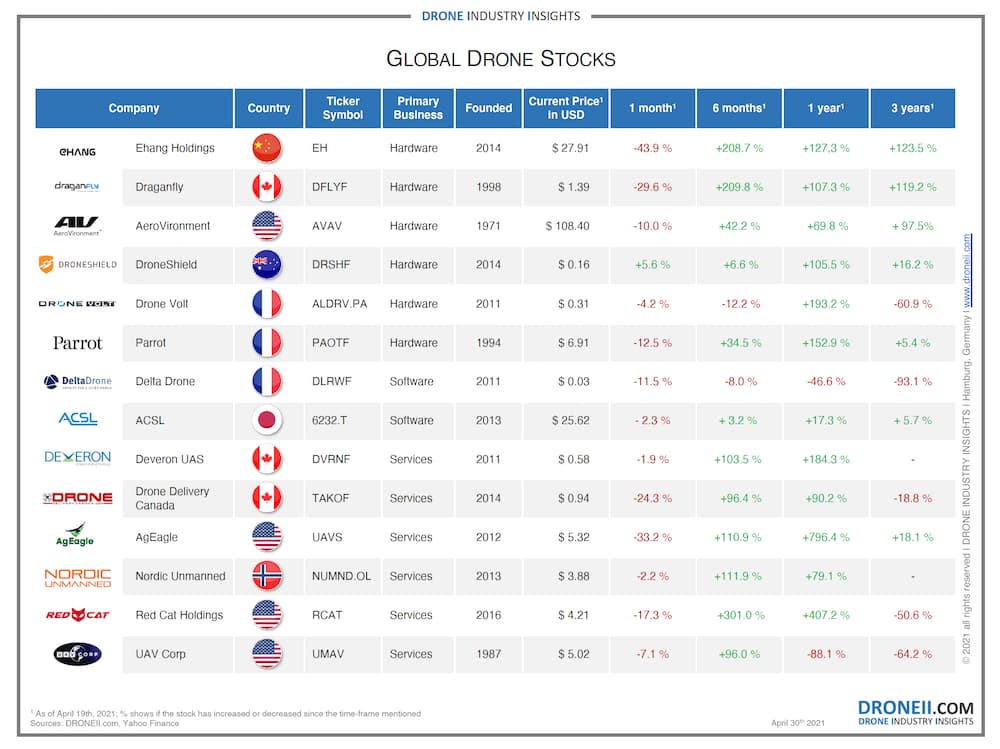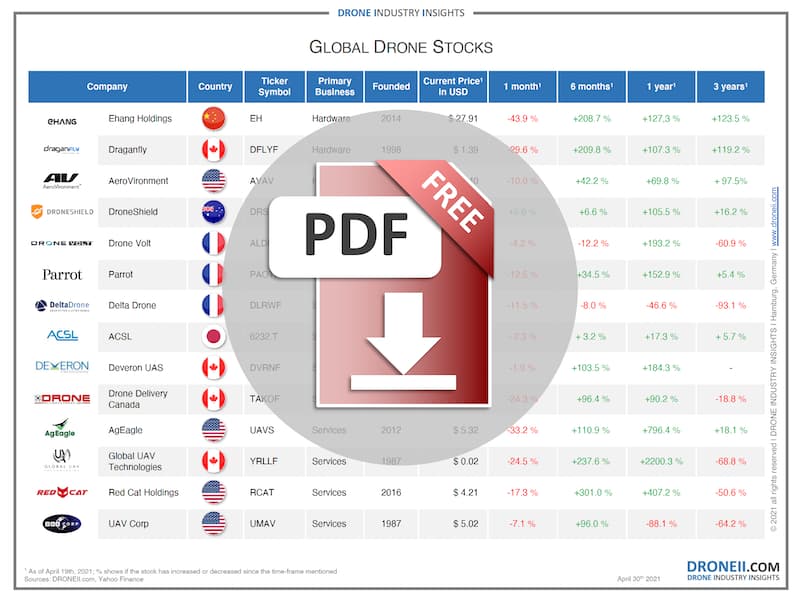- Which companies offer drone stocks that can be traded in financial markets?
- Companies Selling Drone Stocks
- Upcoming Drone Stocks
- SPACs and Drone Stocks
- Drone Stocks in Financial Markets
- Conclusion: The Future of Drone Stocks
Drone Stocks, SPACs, and Financial Markets
Which companies offer drone stocks that can be traded in financial markets?
From the outset, it’s worth clarifying that this article is about drone stocks. It’s not about massive non-drone companies that have entered the drone market or about other corporations that specialize in something else that is not drones (e.g. components or accessories). That is why we will not mention companies often included in other “drone stock” articles such as: Amazon, Boeing, GoPro, Nvidia, Ambarella, Autel Robotics, Kratos Defense and Security Solutions, or Northrop Grumman (NOC). Since the topic is publicly-traded stocks, you also won’t see private drone companies such as DJI, 3D Robotics, Yuneec, or others, unless there have been recent talks about them going public (more on this later).
Companies Selling Drone Stocks
This is not a comprehensive list since there are or less known-about or rather inactive companies that are still technically being traded (e.g. UAS Drone Corp, Drone Services USA, or Drone Aviation Corp). Nevertheless, just about all of the companies on this list are included in one of our industry reports, infographics, or white papers. Rather than providing details about each, they can be broken down as follows.
In terms of the offerings by these 14 companies, it is hard to draw a line to categorize them into hardware, software, or services, given that many of them are or were active in more than one of these segments. Geographically, there are 7 companies in North America (USA: 4, Canada: 3), 3 in France, and 1 each in Norway, Japan, China and Australia. The oldest company currently offering drone stocks is AeroVironment (1971) while the youngest is Red Cat Holdings (2016), which invests in and owns several subsidiaries providing various services. Although most of these companies were established between 2010 and 2015 (9), there are 4 companies that were founded before 2000, which suggests that drone stocks can certainly be a good long-term investment. As more companies enter stock markets in the coming years, the competition to own shares will likely increase substantially.
Upcoming Drone Stocks
Since the start of 2021, we have already heard of three major news regarding a drone company going public, and all of these are working on air taxis.
- Archer Aviation (ACHR) was founded in 2018 in Palo Alto, California. The company recently received an order worth US$1billion from United Airlines. On 10 February 2021, they announced their plans to go public through a “business combination agreement with Atlas Crest Investment Corp (NYSE: ACIC)”. The company is valued at approximately $3.8 billion and drone stocks will be sold at the US$10.00 under the ticker symbol ACHR.
- Joby Aviation, founded in 2009 in Santa Cruz, California, reached an agreement with Reinvent Technology Partners (“Reinvent” or “RTP”) (NYSE:RTP) on 24 February 2021. This is after it acquired Uber Elevate in December 2020 and reached a total of US$820 million in funding. The combined company is valued at $6.6 billion, and one reason for this higher valuation is the unprecedented structure of their deal where founder shares are locked up for 5 years and “a robust earnout structure with full vesting [is] not realized until the share price reaches $50 per share (implying over a $30 billion market capitalization).” Shares will also be sold at US$10.00 per share, though the drone stock ticker symbol has not been clearly defined yet.
- Lilium (LILM), founded in 2015 in Munich, Germany is the only non-American company that has made this announcement in 2021. Their deal with Qell Acquisition Corp.(“Qell”) (Nasdaq: QELL) was recently made public on 30 March 2021 and the transaction values the combined company at approximately $3.3 billion. Once again, the shares will be sold at the price of $10 under the ticker symbol LILM.
Though hundreds of companies might also be considering going public, other companies that could seek this in the near future and are worth mentioning include: Volocopter founded in 2011in Bruchsal, Germany and who received a €200/$241M Series D Funding in February. Wisk founded as a venture by Boeing and Kitty-Hawk in 2019 in Mountain View, California, USA who recently completed trials in New Zealand. Skydio founded in 2014 in Redwood City, California, USA and has received a total funding of $340M to date. Vertical Aerospace founded in 2016 in Bristol, United Kingdom and has reported Rolls-Royce powered systems. However, we will have to stay tuned for the latest developments of these and other companies to see if and when they decide to offer drone stocks.
Those who follow financial partnerships closely might have noticed that all three of the latest drone companies that decided to go public are making use of what is called a SPAC (Special Purpose Acquisition Company). These are the non-drone companies listed above as the merger partners of Archer, Joby, and Lilium (i.e. Atlas, Reinvent, and Qell respectively). Perhaps many people in the drone industry are not aware of what exactly a SPAC is or how it is different from an IPO (initial public offering), which brings us to our next topic.
SPACs and Drone Stocks
Special Purpose Acquisition Companies first appeared in 1993. In the simplest of terms, a SPAC is a “shell company” (meaning it doesn’t make or sell anything) whose only purpose is to acquire another company before a certain deadline. Once the SPAC is created by investors, an IPO allows people to buy shares of the company, but these people often don’t know which other company will ultimately be acquired. The acquisition of the company needs to happen by a certain deadline (typically 24 months), otherwise the SPAC will be dissolved and the IPO proceeds will be returned to the investors. All of this explains why sometimes SPACs are referred to as “blank check companies” since they have the money but there is no concrete plan on where to spend it.
SPACs provide a quicker way for drone companies to enter the market because they already had an IPO and is already publicly traded, which means the drone company simply has to merge with it rather than spending all the time and paperwork doing these things to enter the stock market. As more drone companies grow and seek to become public to sell drone stocks, we will see more and more of an overlap between the drone market and financial tools such as SPACs.
Drone Stocks in Financial Markets
At the start of 2021, EHang provided us with some major headlines regarding drones and financial markets. In early February, there were rumors about a partnership with Volkswagen that made these drone stocks go up. This came in addition to successful tests, support from the Chinese government, and other agreements that the company made. But just a couple of weeks later their stocks plummeted more than 60% in a single day after a short-seller claimed that the company had “grossly misrepresented its revenue, intellectual property, and progress”. However, by early March, when the hyper-focus on the company had died down, EHang was once again described as “a company that investors should consider” despite the controversy.
This is only one case, yet it shows that drone stocks are just like any other stock: they rise and fall based on the latest developments. Some might argue that the average stock prices for drone companies have on average mostly decreased in the past decades, but perhaps that is also because drone companies and industries have been specializing. What was once called “a drone” or “model aircraft” can now be split into air taxis or passenger drones, unmanned air vehicles, delivery drones, drone-detection or counter-drone devices, among other things. This, in combination with major companies entering the drone market, might make it harder to determine the performance of drone stocks specifically (e.g. since Boeing’s or Amazon’s stock could have gone up based on a drone-related project).
Conclusion: The Future of Drone Stocks
In conclusion, there are more drone-specific stocks than most people might realize or try to look for. This article started off by naming 14 drone-specific companies with shares currently being traded in stock markets. One of these companies is EHang, whose stock made international news for weeks, and the rise of urban air mobility has led to even more major headlines about upcoming drone stocks. As of May 2021, there are [at least] three passenger drone companies who will become publicly-traded in the coming months. Their IPO process is sped up thanks to mergers with SPACs, and as more drone companies mature and leverage their technologies, we are likely to see many more of them follow suit into financial markets.
Yet in a disruptive and ever-evolving sector such as drone tech, there is no linear growth on stock prices. There is always a threat of a short-seller damaging the reputation of a company or the industry for the sake of financial gain and not for the merit of the technology. So the key takeaway of this introductory article into drone stocks is that drone-specific companies are indeed out there being publicly-traded, and there will be more. Given how rapidly the technology is evolving and specializing, perhaps by 2030 we will have an umbrella that includes “passenger drone stocks” and “counter-drone stocks” rather than merely “drone stocks”.
Download our FREE Infographic: Drone Stock Overview 2021
This infographic “Drone Stock Overview 2021” shows companies that offer drone stocks as well as their development in the recent past.

Before working with drones, Ed acquired vast experience in Communications and Diplomacy. He holds a Master’s in International Relations, Bachelor’s in Economics & Philosophy, and has lived in 7 countries.




